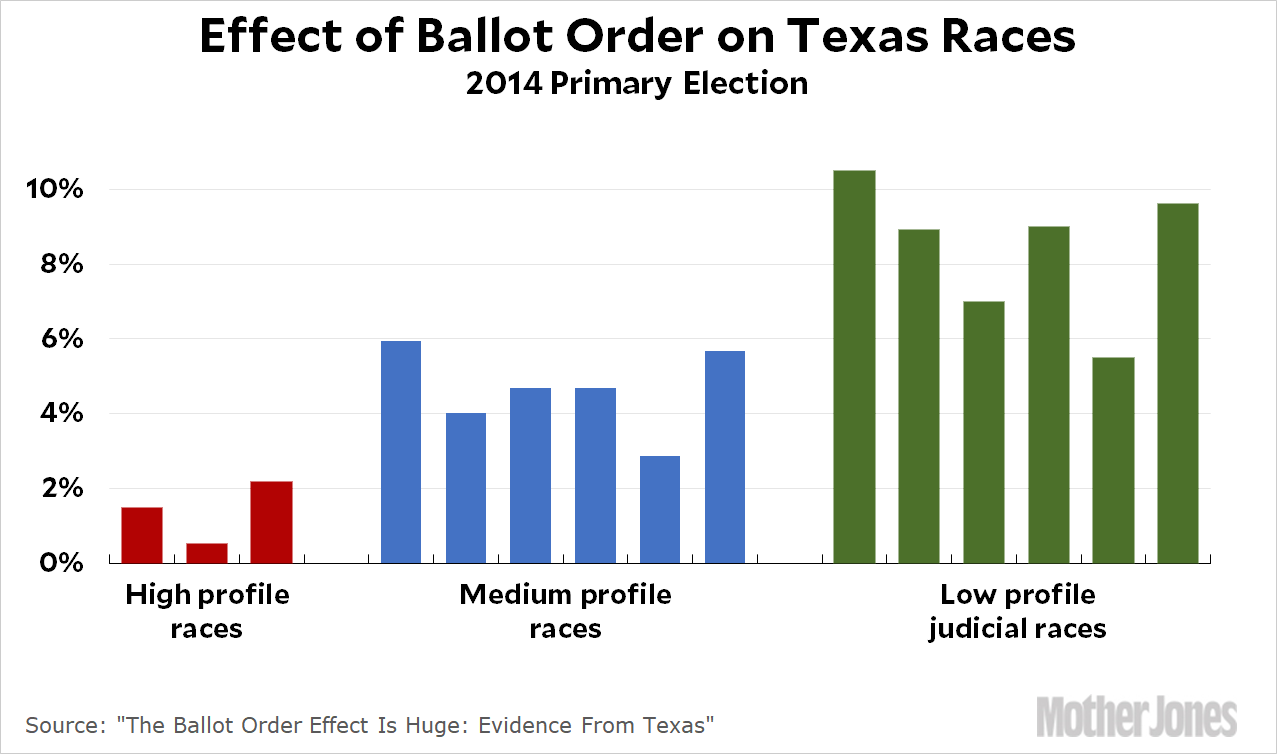Here’s a fascinating bit of political science research. It’s a few months old, but I just recently found out about it. In Texas, names are placed on the ballot in different orders depending on the county. The order is selected randomly, which allows an examination of whether being first on the ballot matters very much. Darren Grant of Sam Houston State University did exactly that, and he found that it really, really makes a difference:
Across all twenty-four contests, the effect is invariably positive and, with two exceptions in runoff elections, statistically significant. The smallest effects are found in high-profile, high information races: the Republican primary for U.S. Senator, which featured the incumbent, John Cornyn; the governor’s race, which featured long-time Attorney General Greg Abbott; and Land Commissioner, which featured well-known political newcomer George P. Bush. In these races the ballot order effect is only one or two percentage points.
Larger estimates obtain for most “medium-profile, medium-information” races such as Comptroller, Railroad Commissioner, or the Democratic nominee for U.S. Senator. Most of these fall in a fairly tight band that ranges from three to five percentage points. Estimates are even larger in the low-profile, low-information judicial elections, generally ranging from seven to ten percentage points. Overall, the ballot order effect tends to be larger in contests that receive less attention and in which voters are likely to know less about the candidates on the ballot.
Here this is in colorful chart form:

In medium and low-profile races, the ballot order effect is big enough that it might decide races all by itself. Even in high-profile races, “one or two percentage points” can be a pretty big effect. There are plenty of races for governor or senator that have been won by less.
In states that don’t randomize ballot order, this means that the first candidate on the ballot has a huge advantage. And this could be true even in states that do. If you got lucky and ended up at the top of the ballot in Houston, Dallas, and San Antonio, you’d get an advantage in areas with millions of votes, while your opponent would get an advantage in areas with only thousands of votes. And there are certain unusual circumstances where the ballot order effect can be truly massive:
In an ironic twist of fate, we were recently able to [test our hypothesis] with the March, 2016 Texas Republican primary, held just after the first draft of this paper was completed. Featuring a highly visible Presidential race, it drew twice as many voters as in 2014—and had contests for three Supreme Court positions, one of which was between Paul Green and Rick Green, two men with common first names and identical last names. It was The Perfect Storm, and our logic implies that this should lead to large ballot order effects. This is immediately evident in the histogram of county vote shares presented in Figure 2(a), without even looking at ballot order: in a race won with 52.1% of the statewide vote, virtually no county’s vote was nearly evenly split. Instead Paul Green’s vote shares are bifurcated into two clusters, one around 40%, and another around 60%, suggesting a ballot order effect approaching twenty percentage points. The regression results in Figure 2(c) confirm this: the coefficient estimate is 19.4 percentage points. We have never seen a ballot order effect this large, and may never again.
Since different counties had different ballot orders, this might not have made a difference in the final result. But with an effect that gigantic, getting even a little bit lucky with the ballot order in the biggest cities might have made the difference.
I’m not sure if there’s a policy answer to this. At the very least, ballot order should always be randomized. Beyond that, Grant suggests that if you’re not sure who to vote for, vote for the person at the bottom of the ballot. They could use the help.

















